 Technology peripherals
Technology peripherals
 AI
AI
 Thought cloning! Former OpenAI researcher lets AI imitate human thinking, and the real-life version of 'Ex Machina' arrives
Thought cloning! Former OpenAI researcher lets AI imitate human thinking, and the real-life version of 'Ex Machina' arrives
Thought cloning! Former OpenAI researcher lets AI imitate human thinking, and the real-life version of 'Ex Machina' arrives
What will happen when AI has autonomous consciousness?
In "Ex Machina", Ava takes advantage of human sympathy and deceives humans to gain freedom, eventually killing her "creator" Nathan.

Recently, under the recommendation of many netizens, Sam Altman finally watched this movie.
and said, "It's a good movie, but I don't understand why everyone makes me watch it."

Many people may want to warn that this is the result of making artificial intelligence conscious and passing the Turing test.
But we are still far away from the scene of "Ex Machina" being released. GPT-5 may be under secret development. Making AI smart is still what scientists want to do with all their strength. thing.
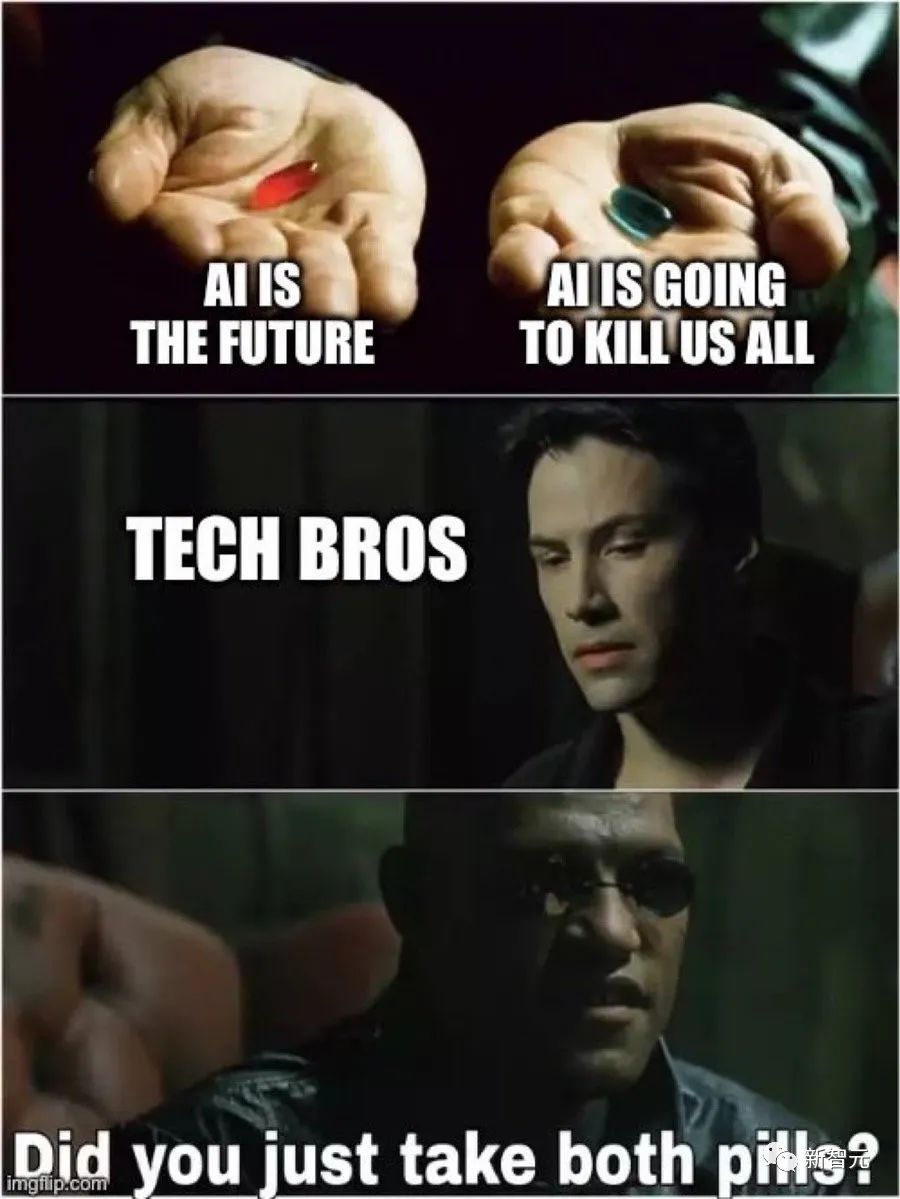
No, two researchers from the University of British Columbia have discovered that there are many advantages to intelligent agents that can think like humans.
In the latest paper, they studied the "thought cloning" (TC) of intelligent agents.
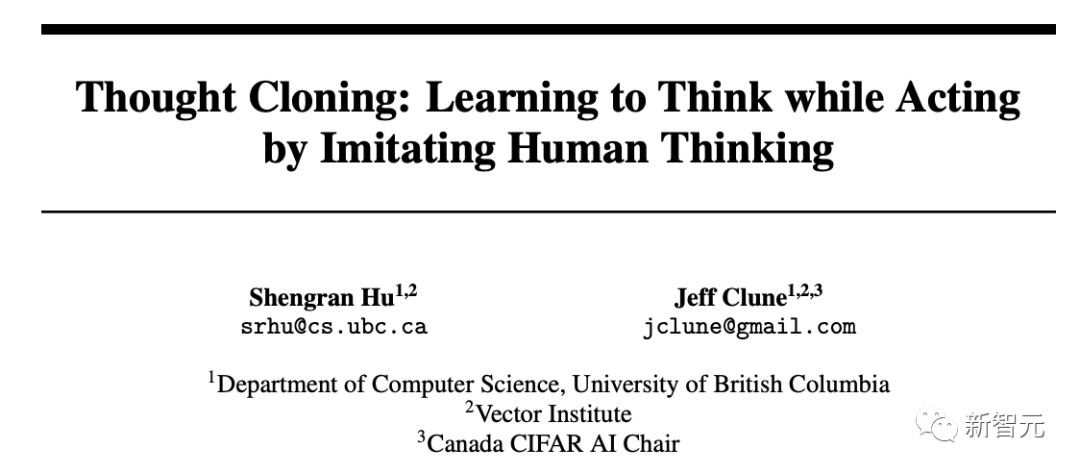
##Here, artificial intelligence learns to "think" and "act" like humans by imitating humans.
When AI has thoughtsYou must know that language is the key to distinguishing humans from other creatures.
Therefore, researchers imagine that if an agent can understand language, there will be many benefits.

For example, help humans summarize, infer, adapt to new situations, and combine new methods with existing knowledge, Explore, plan, and re-plan when necessary.
Despite these benefits, AI agents rarely think, at least not in human language.
While neural networks can be thought of as internal vector activations for thinking, many people hypothesize that thinking in discrete, symbolic language has specific benefits.
This means that an agent that can think in language may learn faster and perform and generalize better than an agent that does not use language.
For all these reasons, enhancing the ability of AI agents to think in language can yield many significant advantages.
Jeff Clune and Shengran Hu believe that the most effective way to achieve this goal is to "let AI imitate human thinking."
They found that humans do not acquire thinking skills in isolation. Instead, they learn part of their skills through the example of others and feedback provided by teachers.
Therefore, an effective approach is to let the agent learn from demonstrations of humans speaking their thoughts while acting.
This approach differs from existing work using pre-trained LLMs for planning because these LLMs have not been trained on data of humans speaking their thoughts while acting, i.e. "thought data" ”.
As for the source of "thought data", the researchers selected YouTube videos and text recordings, which contain approximately millions of hours, including the thoughts behind people's actions, plans, decisions and re-planning.
In the paper, the researchers proposed a novel imitation learning framework "thought cloning". Among them, the agent not only learns human demonstration behaviors, such as behavioral cloning, but also learns the way humans think while acting.
In the thought cloning training framework, the agent learns to generate thoughts at each time step and subsequently adjusts actions based on these thoughts.
The overall framework is as shown in the figure. The TC agent is a two-layer architecture: upper layer and lower layer components.
At each time step, the agent receives an observation, a task, and a thought history as input. The upper-level component is responsible for generating ideas, and the lower-level component generates and executes operations conditional on these ideas.
The generated thoughts and actions are then compared to the ground truth in the demo dataset to calculate the loss.
While there may be different choices for the conditions of the upper and lower components, in this work, for a specific trajectory of length t in the thinking dataset, the researchers minimized it:

For more complex or large-scale scenarios, upper-layer components can be implemented using pre-trained visual language models (VLM) , or zero-sample, fine-tuning.
The underlying components can be trained from scratch or adapted from existing language conditional controllers in the target domain.
In the paper, the researchers conducted research based on two components of the BabyAI 1.1 model architecture.
This model utilizes the memory-enhanced architecture LSTM to solve the challenge of partial observability. In addition, it adopts FiLM for modal fusion, effectively combining visual and textual inputs.
Here, the author particularly emphasizes that all models in this article are trained from scratch, but it is better to use pre-trained models in complex fields.
The picture below is an example of the BabyAI environment. The picture on the left contains items of various colors (balls, keys, boxes, doors).

The agent can pick up, put down, move objects or open and close doors, while the lock The door you live in can only be opened with a color-matched key.
The agent can see the 7×7 grid cells in front of it, which are blocked by walls and closed doors.
The task of the "Thought Clone" agent is to reach the purple box (highlighted) and start planning the route.
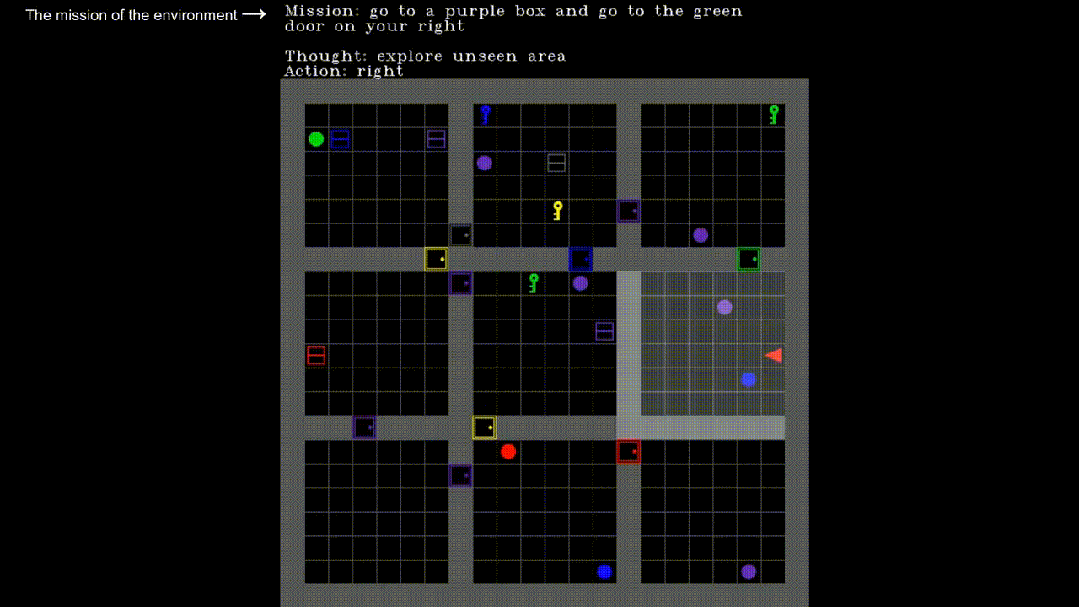
#But when it opened the blue door and was about to complete the task, it found a purple ball blocking the way. . Therefore, the thought clone agent is re-planned.
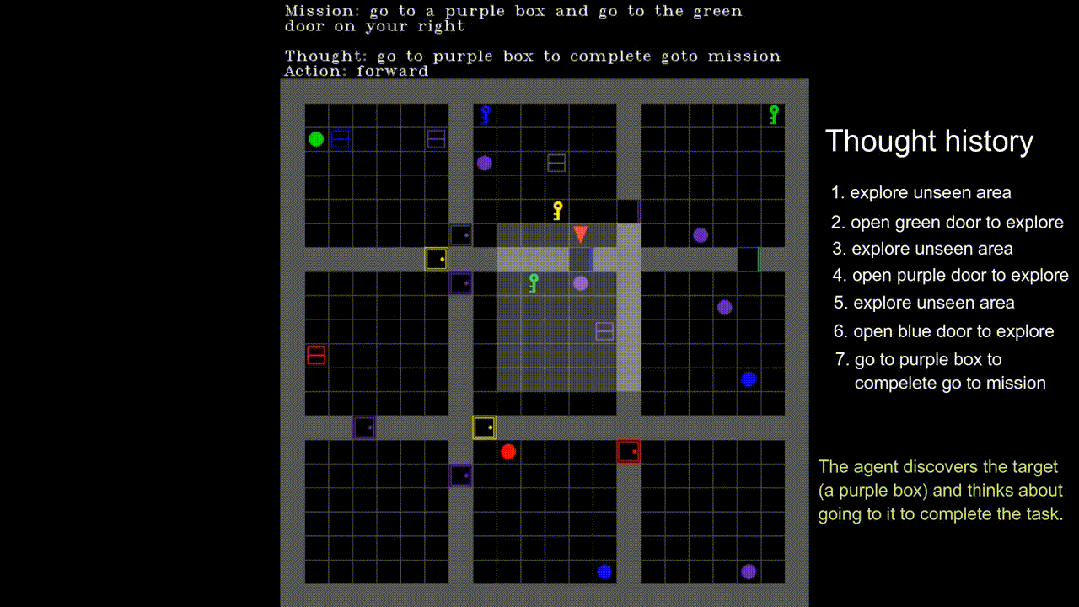
##It can be seen that the thoughts and actions of the agent show that when encountering obstacles, first remove them Remove and re-route before continuing to the previous goal.
This process is especially like how Ava planned step by step to make human beings finally believe in and help themselves to escape from the long-held glass cage.
Experimental results
The research results show that "thought cloning" is better than behavioral cloning.
Furthermore, in zero-shot and fine-tuning settings, thought cloning has greater advantages than behavioral cloning in out-of-distribution tasks.
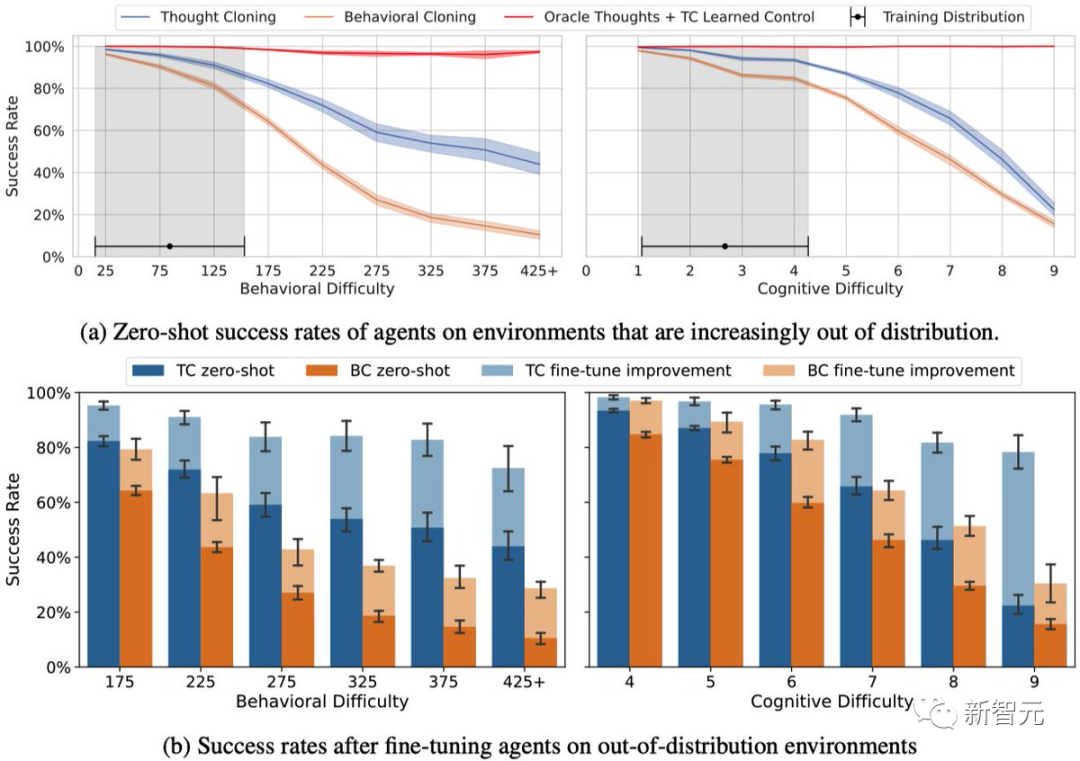
Interestingly, the researchers also developed “pre-crime intervention” that allows users to still Define unsafe behavior.
The agent can be terminated when dangerous thoughts are detected. In the test, the effect of "pre-crime intervention" was almost perfect, showing its potential in artificial intelligence security.
"Thought cloning" not only makes artificial intelligence smarter, but also safer and easier to understand.
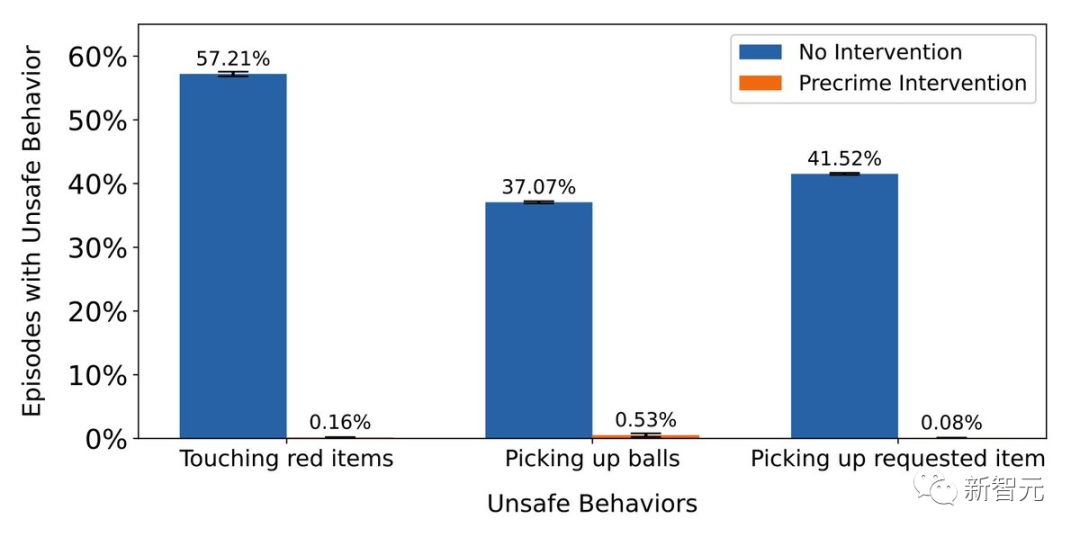
That is to say, before the AI commits a crime, everything can still be saved.

In Jeff Clune’s view, “thought cloning” contributes to the safety of artificial intelligence.
Because we can observe the agent’s thoughts: (1) can more easily diagnose why things go wrong, (2) guide the agent by correcting its thoughts, ( 3) Or prevent it from doing the unsafe thing it planned.

About the author
Jeff Clune
Currently, Jeff Clune is an associate professor of computer science at the University of British Columbia. He mainly studies deep learning, including deep reinforcement learning.
Previously, he was the head of the OpenAI research team and the senior research manager and founding member of the Uber Artificial Intelligence Laboratory.

Previously, he and the OpenAI team released a video pre-training model-VPT, allowing AI to operate in Minecraft Learning stone-making pickaxes from video data.
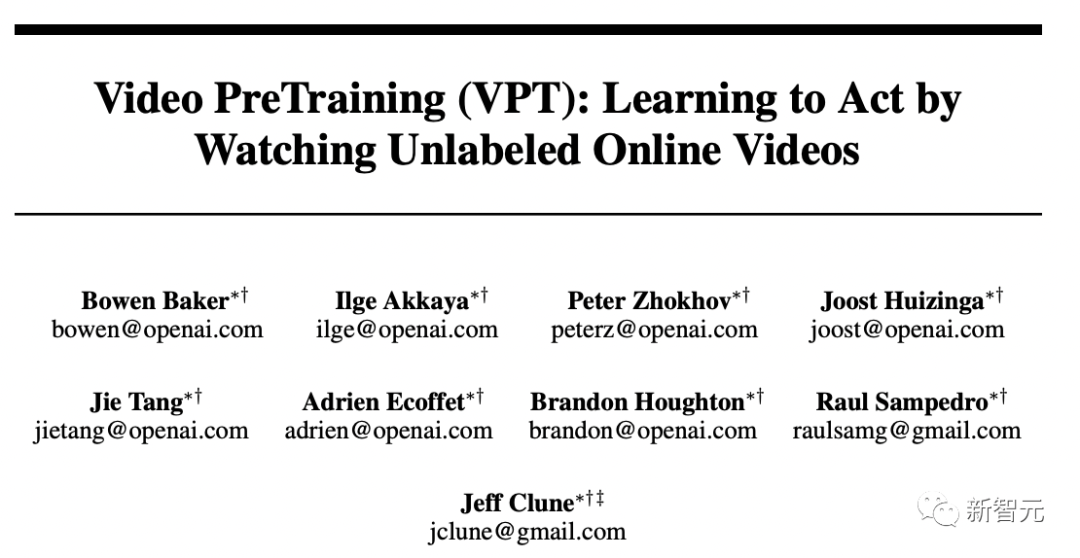
Shengran Hu
Currently Britain PhD student at Columbia University, interested in deep learning and artificial intelligence generation algorithms.

The above is the detailed content of Thought cloning! Former OpenAI researcher lets AI imitate human thinking, and the real-life version of 'Ex Machina' arrives. For more information, please follow other related articles on the PHP Chinese website!

Hot AI Tools

Undresser.AI Undress
AI-powered app for creating realistic nude photos

AI Clothes Remover
Online AI tool for removing clothes from photos.

Undress AI Tool
Undress images for free

Clothoff.io
AI clothes remover

Video Face Swap
Swap faces in any video effortlessly with our completely free AI face swap tool!

Hot Article

Hot Tools

Notepad++7.3.1
Easy-to-use and free code editor

SublimeText3 Chinese version
Chinese version, very easy to use

Zend Studio 13.0.1
Powerful PHP integrated development environment

Dreamweaver CS6
Visual web development tools

SublimeText3 Mac version
God-level code editing software (SublimeText3)

Hot Topics
 Decryption Gate.io Strategy Upgrade: How to Redefine Crypto Asset Management in MeMebox 2.0?
Apr 28, 2025 pm 03:33 PM
Decryption Gate.io Strategy Upgrade: How to Redefine Crypto Asset Management in MeMebox 2.0?
Apr 28, 2025 pm 03:33 PM
MeMebox 2.0 redefines crypto asset management through innovative architecture and performance breakthroughs. 1) It solves three major pain points: asset silos, income decay and paradox of security and convenience. 2) Through intelligent asset hubs, dynamic risk management and return enhancement engines, cross-chain transfer speed, average yield rate and security incident response speed are improved. 3) Provide users with asset visualization, policy automation and governance integration, realizing user value reconstruction. 4) Through ecological collaboration and compliance innovation, the overall effectiveness of the platform has been enhanced. 5) In the future, smart contract insurance pools, forecast market integration and AI-driven asset allocation will be launched to continue to lead the development of the industry.
 Which of the top ten currency trading platforms in the world are the latest version of the top ten currency trading platforms
Apr 28, 2025 pm 08:09 PM
Which of the top ten currency trading platforms in the world are the latest version of the top ten currency trading platforms
Apr 28, 2025 pm 08:09 PM
The top ten cryptocurrency trading platforms in the world include Binance, OKX, Gate.io, Coinbase, Kraken, Huobi Global, Bitfinex, Bittrex, KuCoin and Poloniex, all of which provide a variety of trading methods and powerful security measures.
 How to use the chrono library in C?
Apr 28, 2025 pm 10:18 PM
How to use the chrono library in C?
Apr 28, 2025 pm 10:18 PM
Using the chrono library in C can allow you to control time and time intervals more accurately. Let's explore the charm of this library. C's chrono library is part of the standard library, which provides a modern way to deal with time and time intervals. For programmers who have suffered from time.h and ctime, chrono is undoubtedly a boon. It not only improves the readability and maintainability of the code, but also provides higher accuracy and flexibility. Let's start with the basics. The chrono library mainly includes the following key components: std::chrono::system_clock: represents the system clock, used to obtain the current time. std::chron
 Recommended reliable digital currency trading platforms. Top 10 digital currency exchanges in the world. 2025
Apr 28, 2025 pm 04:30 PM
Recommended reliable digital currency trading platforms. Top 10 digital currency exchanges in the world. 2025
Apr 28, 2025 pm 04:30 PM
Recommended reliable digital currency trading platforms: 1. OKX, 2. Binance, 3. Coinbase, 4. Kraken, 5. Huobi, 6. KuCoin, 7. Bitfinex, 8. Gemini, 9. Bitstamp, 10. Poloniex, these platforms are known for their security, user experience and diverse functions, suitable for users at different levels of digital currency transactions
 What are the top currency trading platforms? The top 10 latest virtual currency exchanges
Apr 28, 2025 pm 08:06 PM
What are the top currency trading platforms? The top 10 latest virtual currency exchanges
Apr 28, 2025 pm 08:06 PM
Currently ranked among the top ten virtual currency exchanges: 1. Binance, 2. OKX, 3. Gate.io, 4. Coin library, 5. Siren, 6. Huobi Global Station, 7. Bybit, 8. Kucoin, 9. Bitcoin, 10. bit stamp.
 How to measure thread performance in C?
Apr 28, 2025 pm 10:21 PM
How to measure thread performance in C?
Apr 28, 2025 pm 10:21 PM
Measuring thread performance in C can use the timing tools, performance analysis tools, and custom timers in the standard library. 1. Use the library to measure execution time. 2. Use gprof for performance analysis. The steps include adding the -pg option during compilation, running the program to generate a gmon.out file, and generating a performance report. 3. Use Valgrind's Callgrind module to perform more detailed analysis. The steps include running the program to generate the callgrind.out file and viewing the results using kcachegrind. 4. Custom timers can flexibly measure the execution time of a specific code segment. These methods help to fully understand thread performance and optimize code.
 How much is Bitcoin worth
Apr 28, 2025 pm 07:42 PM
How much is Bitcoin worth
Apr 28, 2025 pm 07:42 PM
Bitcoin’s price ranges from $20,000 to $30,000. 1. Bitcoin’s price has fluctuated dramatically since 2009, reaching nearly $20,000 in 2017 and nearly $60,000 in 2021. 2. Prices are affected by factors such as market demand, supply, and macroeconomic environment. 3. Get real-time prices through exchanges, mobile apps and websites. 4. Bitcoin price is highly volatile, driven by market sentiment and external factors. 5. It has a certain relationship with traditional financial markets and is affected by global stock markets, the strength of the US dollar, etc. 6. The long-term trend is bullish, but risks need to be assessed with caution.
 What are the top ten virtual currency trading apps? The latest digital currency exchange rankings
Apr 28, 2025 pm 08:03 PM
What are the top ten virtual currency trading apps? The latest digital currency exchange rankings
Apr 28, 2025 pm 08:03 PM
The top ten digital currency exchanges such as Binance, OKX, gate.io have improved their systems, efficient diversified transactions and strict security measures.





